AB Svenska Biografteatern, also called Svenska Bio, was a film company operating between 1907 and 1919. During the 1910s, Svenska Bio became internationally recognised with films directed by the former stage directors Victor Sjöström and Mauritz Stiller. In 1913, Sjöström directed Ingeborg Holm (1913), which is now considered the first classic of Swedish cinema. A year later, Svenska Bio introduced feature films in the Swedish cinema. In 1919 Svenska Bio merged with Filmindustri AB Skandia and continued its operations as Svensk Filmindustri AB.
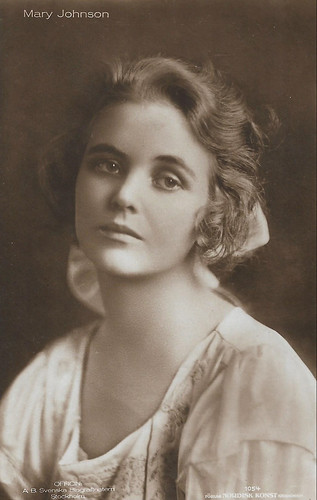
Mary Johnson. Swedish postcard by Förlag Nordisk Konst, Stockholm, no. 1054. Photo: A.B. Svenska Biografteatern, Stockholm.
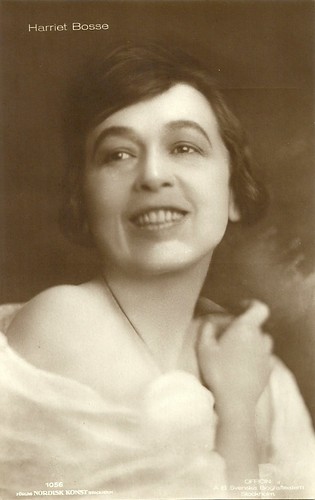
Harriet Bosse. Swedish postcard by Förlag Nordisk Konst, Stockholm, no. 1056. Photo: A.B. Svenska Biografteatern, Stockholm.
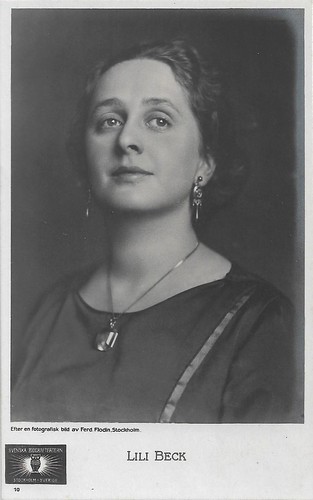
Lili Beck. Swedish postcard by Svenska Biografteatern, Stockholm, no. 10. Photo: Ferd. Flodin, Stockholm.
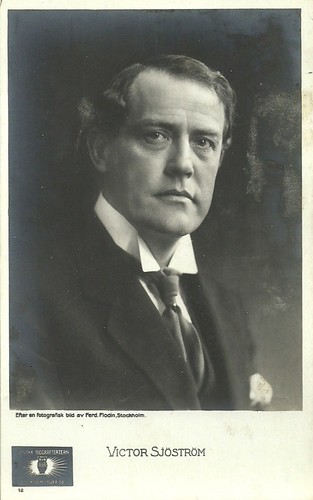
Victor Sjöström. Swedish postcard by Svenska Biografteatern, Stockholm, no. 12. Photo: Ferd. Flodin, Stockholm.
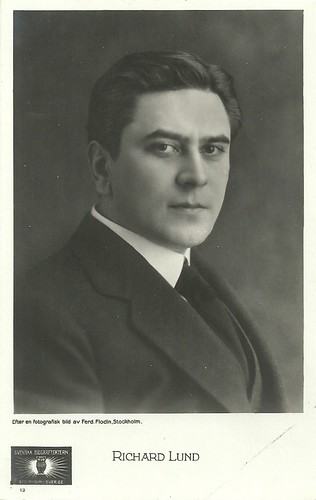
Richard Lund. Swedish postcard by Svenska Biografteatern, Stockholm, no. 13. Photo: Ferd. Flodin, Stockholm.
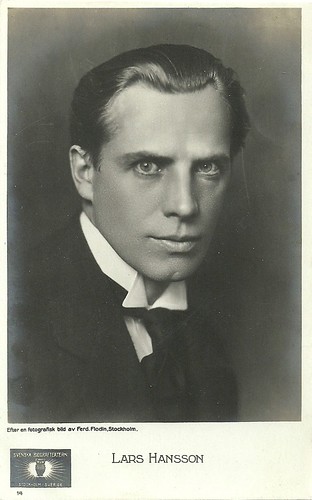
Swedish postcard by Svenska Biografteatern, Stockholm, no. 14. Photo: Ferd. Flodin, Stockholm. Lars Hanson's last name is spelled Hansson on this card.
Sweden has only a small population, but no other country matched the fame of the Swedish cinema during the 1910s and 1920s. The main Swedish studio at the time was AB Svenska Biografteatern, or Svenska Bio.
AB Svenska Biografteatern was formed in 1907 through a conversion of Handelsbolaget Kristianstad Biograf-Teater with a share capital of SEK 150,000 and Nils H. Nylander as the first CEO. At first, the company owned about twenty cinemas and had 170 employees.
The company was based in Kristianstad and engaged in production, distribution and exhibition of films. Svenska Bio produced the first Swedish city films in 1907. These were films that portrayed the places where cinemas were opened.
In 1909, Charles Magnusson became the new CEO, and he would become the major, central figure in Swedish film life. Thanks to him, the number of cinemas grew to some forty around the country. AB Svenska Biografteatern inaugurated in March 1909 its newly built film palace in Kristianstad. In addition to the cinema Cosmorama (about 300 seats), the building also houses workshops, offices, film stores, laboratories and a film studio, that was Sweden's first. The film palace is now the Film Museum in Kristianstad.
Four years later Svenska Bio was the only major player in the Swedish production market. Pathé withdrew after a clash with the Swedish censorship board. Most smaller film companies went bankrupt when multiple film-reel became the new film mode. So Svenska Bio became a monopolist in Sweden and even began to export films to other European nations.
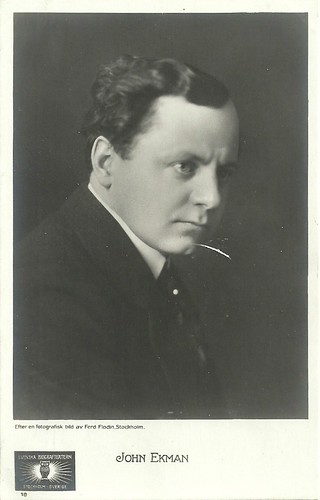
John Ekman. Swedish postcard by Svenska Biografteatern, Stockholm, no. 18. Photo: Ferd. Flodin, Stockholm.
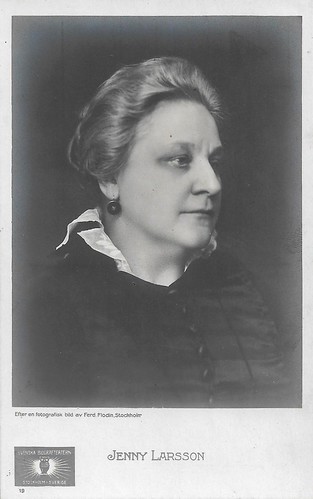
Jenny Larsson aka Jenny Tschernichin-Larsson. Swedish postcard by Svenska Biografteatern, Stockholm, no. 19. Photo: Ferd. Flodin, Stockholm.
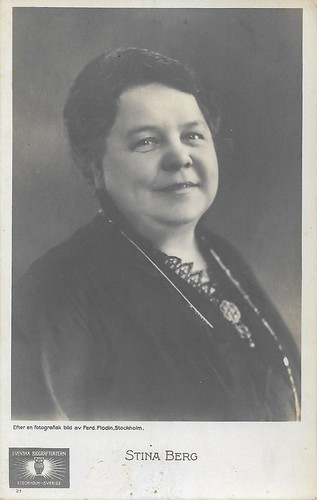
Stina Berg. Swedish postcard by Svenska Biografteatern, Stockholm, no. 21. Photo: Ferd. Flodin, Stockholm.

Albin Lavén. Swedish postcard by Svenska Biografteatern, Stockholm, no. 22. Photo: Ferd. Flodin, Stockholm.
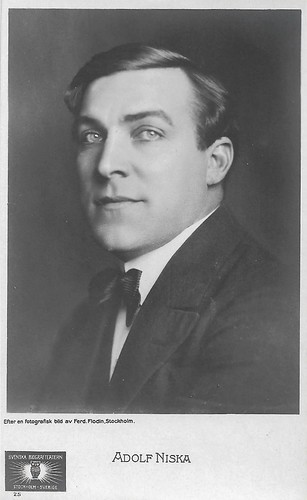
Adolf Niska. Swedish postcard by Svenska Biografteatern, Stockholm, no. 25. Photo: Ferd. Flodin, Stockholm.
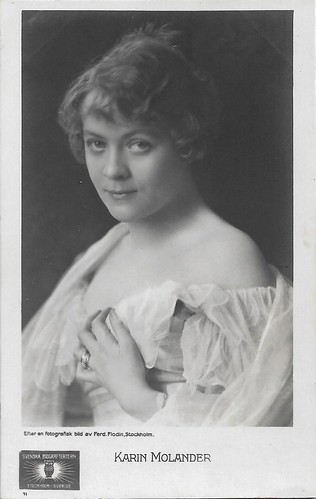
Karin Molander. Swedish postcard by Svenska Biografteatern, Stockholm, no. 71. Photo: Ferd. Flodin, Stockholm.
In 1911 Svenska Bio moved to Lidingö, a municipality east of Stockholm. In 1912, three directors were working at the studio: Georg af Klercker, who was also the studio manager, and the stage directors Mauritz Stiller and Victor Sjöström. Magnusson had hired them both as actor-director. The two would become Sweden's most famous film pioneers.
Stiller and Sjöström came to record some sixty films in Lidingöateljén up until 1917. Ingeborg Holm (Victor Sjöström, 1913) is considered the earliest masterpiece in the Swedish silent film. The film tells the story of Ingeborg Holm who loses her mind when she loses her husband and children. The social commentary in the film lead to a heated debate about the shortcomings of poor care.
Other famous films made in Sweden during that time are Terje Vigen (Victor Sjöström, 1917) after a script by Gustaf Molander, Berg-Ejvind och hans hustru/The Outlaw and His Wife (Victor Sjöström, 1918), and Herr Arnes pengar/Sir Arne's Treasure (Mauritz Stiller, 1919) and others.
In 1914, the company began production and screenings of Svenska Bios weekly. These were the first Swedish film journals. In 1919 Svenska Bio bought land in Råsunda, where the studio planned to build a film city with two studios.
Later in 1919 the company joined forces with Filmindustri AB Skandia, founded a year before in 1918, to form the new Svensk Filmindustri AB. The new company, the biggest film studio in Sweden, had its entire business gathered in the newly built film town, and owned a portfolio of 70 cinemas, then one tenth of the total number of permanent cinemas in Sweden.
A year later, the name of the Svenska Bios weekly was changed to the SF journal and continued to be produced under its new name until 1960.
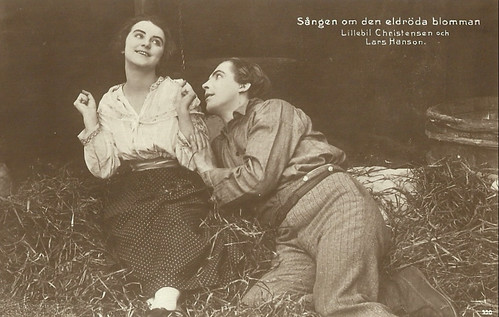
Swedish postcard by Nordisk Konst, Stockholm, no. 550. Photo: Svenska Biografteatern, Stockholm. Publicity still of Lars Hanson' and Lillebil Christensen in Sängen om den eldröda blomman/The Song of the Red Flower (Mauritz Stiller, 1919).

Swedish postcard by Nordisk Konst, Stockholm, no. 843. Photo: Svenska Biografteatern AB. Publicity still for Tösen från Stormyrtorpet/The Girl from the Marsh Croft (Victor Sjöström, 1917), with Karin Molander. Caption: Hildur dressed up as bride.
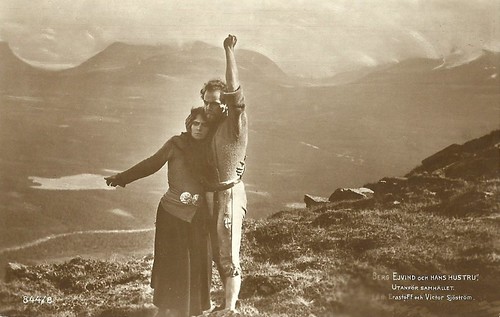
Swedish postcard by Nordisk Konst, Stockholm, no. 844/8. Photo: Svenska Biografteatern AB. Publicity still of Victor Sjöström and Edith Erastoff in Berg-Ejvind och hans hustru/The Outlaw and His Wife (Victor Sjöström, 1918). Caption: Outside society.
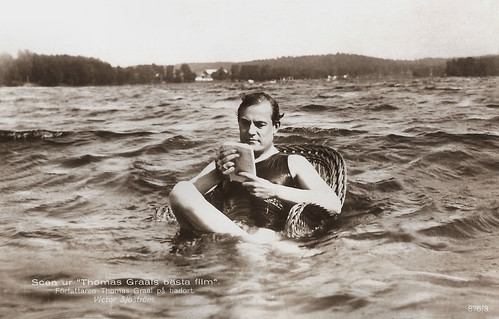
Swedish postcard by Ed. Nordisk Konst, Stockholm, no. 876/3. Photo: Svenska Biografteatern AB. Publicity still for Thomas Graals bästa film/Thomas Graal's Best Film (Mauritz Stiller, 1917), with Victor Sjöström. Caption: The author Thomas Graal at sea.
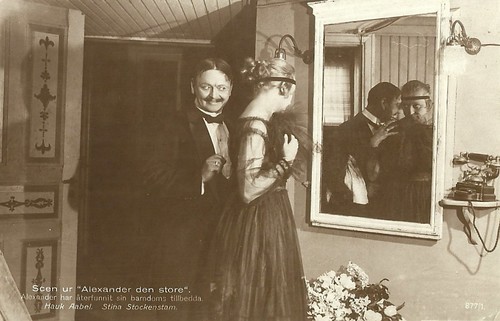
Swedish postcard by Nordisk Konst, Stockholm, no. 877/1. Photo: Svenska Biografteatern AB. Publicity still for the comedy Alexander den Store/Alexander the Great (Mauritz Stiller, 1917) with Hauk Aabel and Stina Stockenstam. The story of the film deals with a provincial hotel cook, named Alexander the Great, in whose restaurant not only the dishes can be spicy. Caption: Alexander has rediscovered his beloved from his youth.
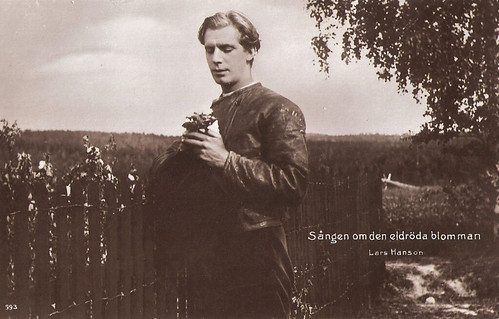
Swedish postcard by Forlag Nordisk Konst, Stockholm, no. 993. Photo: Svenska Biografteatern, Stockholm. Publicity still for Sången om den eldröda blomman/Flame of Life (Mauritz Stiller, 1919) with Lars Hanson'.
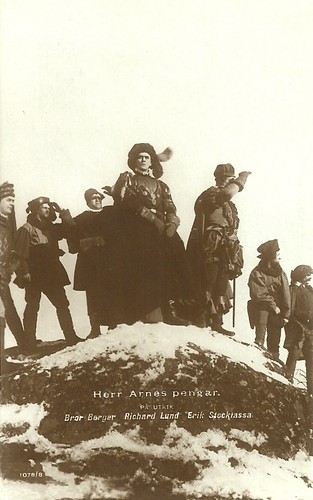
Swedish postcard by Nordisk Konst, Stockholm, no. 1078/8. Richard Lund, Bror Berger and Erik Stocklassa in Herr Arnes pengar/Sir Arne's Treasure (Mauritz Stiller, 1919). Caption: On the Lookout.
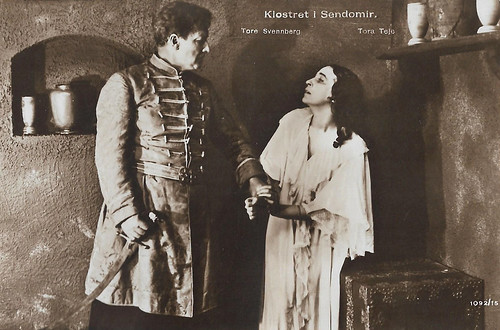
Swedish postcard by Förlag Nordisk Konst, Stockholm, no. 1092/15. Photo: Svenska Biografteatern. Publicity still for Klostret i Sendomir/The Monastery of Sendomir (Victor Sjöström, 1920) with Tore Svennberg and Tora Teje.
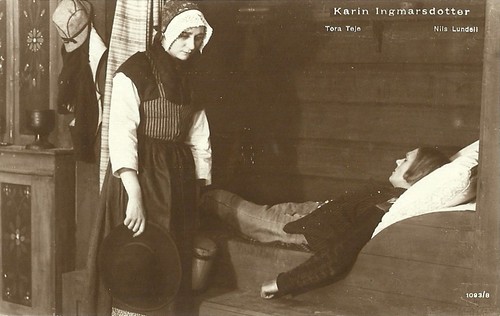
Swedish postcard by Nordisk Konst, Stockholm, no. 1093/8. Photo: Svenska Biografteatren AB. Publicity still for Karin Ingmarsdotter/God/s Way/Karin Daughter of Ingmar (Victor Sjöström, 1920), starring Tora Teje and with Nils Lundell. It is the second part in Sjöström's large-scale adaption of Selma Lagerlöf's novel 'Jerusalem', following Sons of Ingmar from the year before, and depicting chapter three and four from the novel.

Swedish postcard by Förlag Nordisk Konst, Stockholm, no. 1094/4. Photo: Svenska Biografteatern. Publicity still of Karin Molander and Egil Eide in Fiskebyn/The Fishing Village/Chains (Mauritz Stiller, 1920).
Sources: Douglas Gomery, Clara Pafort-Overduin (Movie History: A Survey), Nils Kim Gustafsson (Voodoo Film - Swedish), Wikipedia (Swedish) and IMDb.

Mary Johnson. Swedish postcard by Förlag Nordisk Konst, Stockholm, no. 1054. Photo: A.B. Svenska Biografteatern, Stockholm.

Harriet Bosse. Swedish postcard by Förlag Nordisk Konst, Stockholm, no. 1056. Photo: A.B. Svenska Biografteatern, Stockholm.

Lili Beck. Swedish postcard by Svenska Biografteatern, Stockholm, no. 10. Photo: Ferd. Flodin, Stockholm.

Victor Sjöström. Swedish postcard by Svenska Biografteatern, Stockholm, no. 12. Photo: Ferd. Flodin, Stockholm.

Richard Lund. Swedish postcard by Svenska Biografteatern, Stockholm, no. 13. Photo: Ferd. Flodin, Stockholm.

Swedish postcard by Svenska Biografteatern, Stockholm, no. 14. Photo: Ferd. Flodin, Stockholm. Lars Hanson's last name is spelled Hansson on this card.
The first Swedish film studio
Sweden has only a small population, but no other country matched the fame of the Swedish cinema during the 1910s and 1920s. The main Swedish studio at the time was AB Svenska Biografteatern, or Svenska Bio.
AB Svenska Biografteatern was formed in 1907 through a conversion of Handelsbolaget Kristianstad Biograf-Teater with a share capital of SEK 150,000 and Nils H. Nylander as the first CEO. At first, the company owned about twenty cinemas and had 170 employees.
The company was based in Kristianstad and engaged in production, distribution and exhibition of films. Svenska Bio produced the first Swedish city films in 1907. These were films that portrayed the places where cinemas were opened.
In 1909, Charles Magnusson became the new CEO, and he would become the major, central figure in Swedish film life. Thanks to him, the number of cinemas grew to some forty around the country. AB Svenska Biografteatern inaugurated in March 1909 its newly built film palace in Kristianstad. In addition to the cinema Cosmorama (about 300 seats), the building also houses workshops, offices, film stores, laboratories and a film studio, that was Sweden's first. The film palace is now the Film Museum in Kristianstad.
Four years later Svenska Bio was the only major player in the Swedish production market. Pathé withdrew after a clash with the Swedish censorship board. Most smaller film companies went bankrupt when multiple film-reel became the new film mode. So Svenska Bio became a monopolist in Sweden and even began to export films to other European nations.

John Ekman. Swedish postcard by Svenska Biografteatern, Stockholm, no. 18. Photo: Ferd. Flodin, Stockholm.

Jenny Larsson aka Jenny Tschernichin-Larsson. Swedish postcard by Svenska Biografteatern, Stockholm, no. 19. Photo: Ferd. Flodin, Stockholm.

Stina Berg. Swedish postcard by Svenska Biografteatern, Stockholm, no. 21. Photo: Ferd. Flodin, Stockholm.

Albin Lavén. Swedish postcard by Svenska Biografteatern, Stockholm, no. 22. Photo: Ferd. Flodin, Stockholm.

Adolf Niska. Swedish postcard by Svenska Biografteatern, Stockholm, no. 25. Photo: Ferd. Flodin, Stockholm.

Karin Molander. Swedish postcard by Svenska Biografteatern, Stockholm, no. 71. Photo: Ferd. Flodin, Stockholm.
The earliest masterpiece in the Swedish silent film
In 1911 Svenska Bio moved to Lidingö, a municipality east of Stockholm. In 1912, three directors were working at the studio: Georg af Klercker, who was also the studio manager, and the stage directors Mauritz Stiller and Victor Sjöström. Magnusson had hired them both as actor-director. The two would become Sweden's most famous film pioneers.
Stiller and Sjöström came to record some sixty films in Lidingöateljén up until 1917. Ingeborg Holm (Victor Sjöström, 1913) is considered the earliest masterpiece in the Swedish silent film. The film tells the story of Ingeborg Holm who loses her mind when she loses her husband and children. The social commentary in the film lead to a heated debate about the shortcomings of poor care.
Other famous films made in Sweden during that time are Terje Vigen (Victor Sjöström, 1917) after a script by Gustaf Molander, Berg-Ejvind och hans hustru/The Outlaw and His Wife (Victor Sjöström, 1918), and Herr Arnes pengar/Sir Arne's Treasure (Mauritz Stiller, 1919) and others.
In 1914, the company began production and screenings of Svenska Bios weekly. These were the first Swedish film journals. In 1919 Svenska Bio bought land in Råsunda, where the studio planned to build a film city with two studios.
Later in 1919 the company joined forces with Filmindustri AB Skandia, founded a year before in 1918, to form the new Svensk Filmindustri AB. The new company, the biggest film studio in Sweden, had its entire business gathered in the newly built film town, and owned a portfolio of 70 cinemas, then one tenth of the total number of permanent cinemas in Sweden.
A year later, the name of the Svenska Bios weekly was changed to the SF journal and continued to be produced under its new name until 1960.

Swedish postcard by Nordisk Konst, Stockholm, no. 550. Photo: Svenska Biografteatern, Stockholm. Publicity still of Lars Hanson' and Lillebil Christensen in Sängen om den eldröda blomman/The Song of the Red Flower (Mauritz Stiller, 1919).

Swedish postcard by Nordisk Konst, Stockholm, no. 843. Photo: Svenska Biografteatern AB. Publicity still for Tösen från Stormyrtorpet/The Girl from the Marsh Croft (Victor Sjöström, 1917), with Karin Molander. Caption: Hildur dressed up as bride.

Swedish postcard by Nordisk Konst, Stockholm, no. 844/8. Photo: Svenska Biografteatern AB. Publicity still of Victor Sjöström and Edith Erastoff in Berg-Ejvind och hans hustru/The Outlaw and His Wife (Victor Sjöström, 1918). Caption: Outside society.

Swedish postcard by Ed. Nordisk Konst, Stockholm, no. 876/3. Photo: Svenska Biografteatern AB. Publicity still for Thomas Graals bästa film/Thomas Graal's Best Film (Mauritz Stiller, 1917), with Victor Sjöström. Caption: The author Thomas Graal at sea.

Swedish postcard by Nordisk Konst, Stockholm, no. 877/1. Photo: Svenska Biografteatern AB. Publicity still for the comedy Alexander den Store/Alexander the Great (Mauritz Stiller, 1917) with Hauk Aabel and Stina Stockenstam. The story of the film deals with a provincial hotel cook, named Alexander the Great, in whose restaurant not only the dishes can be spicy. Caption: Alexander has rediscovered his beloved from his youth.

Swedish postcard by Forlag Nordisk Konst, Stockholm, no. 993. Photo: Svenska Biografteatern, Stockholm. Publicity still for Sången om den eldröda blomman/Flame of Life (Mauritz Stiller, 1919) with Lars Hanson'.

Swedish postcard by Nordisk Konst, Stockholm, no. 1078/8. Richard Lund, Bror Berger and Erik Stocklassa in Herr Arnes pengar/Sir Arne's Treasure (Mauritz Stiller, 1919). Caption: On the Lookout.

Swedish postcard by Förlag Nordisk Konst, Stockholm, no. 1092/15. Photo: Svenska Biografteatern. Publicity still for Klostret i Sendomir/The Monastery of Sendomir (Victor Sjöström, 1920) with Tore Svennberg and Tora Teje.

Swedish postcard by Nordisk Konst, Stockholm, no. 1093/8. Photo: Svenska Biografteatren AB. Publicity still for Karin Ingmarsdotter/God/s Way/Karin Daughter of Ingmar (Victor Sjöström, 1920), starring Tora Teje and with Nils Lundell. It is the second part in Sjöström's large-scale adaption of Selma Lagerlöf's novel 'Jerusalem', following Sons of Ingmar from the year before, and depicting chapter three and four from the novel.

Swedish postcard by Förlag Nordisk Konst, Stockholm, no. 1094/4. Photo: Svenska Biografteatern. Publicity still of Karin Molander and Egil Eide in Fiskebyn/The Fishing Village/Chains (Mauritz Stiller, 1920).
Sources: Douglas Gomery, Clara Pafort-Overduin (Movie History: A Survey), Nils Kim Gustafsson (Voodoo Film - Swedish), Wikipedia (Swedish) and IMDb.
No comments:
Post a Comment